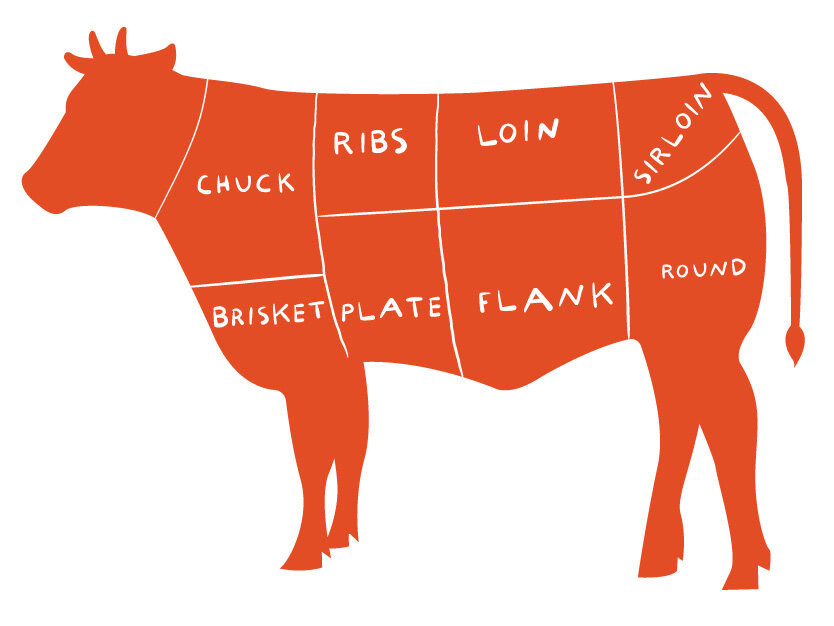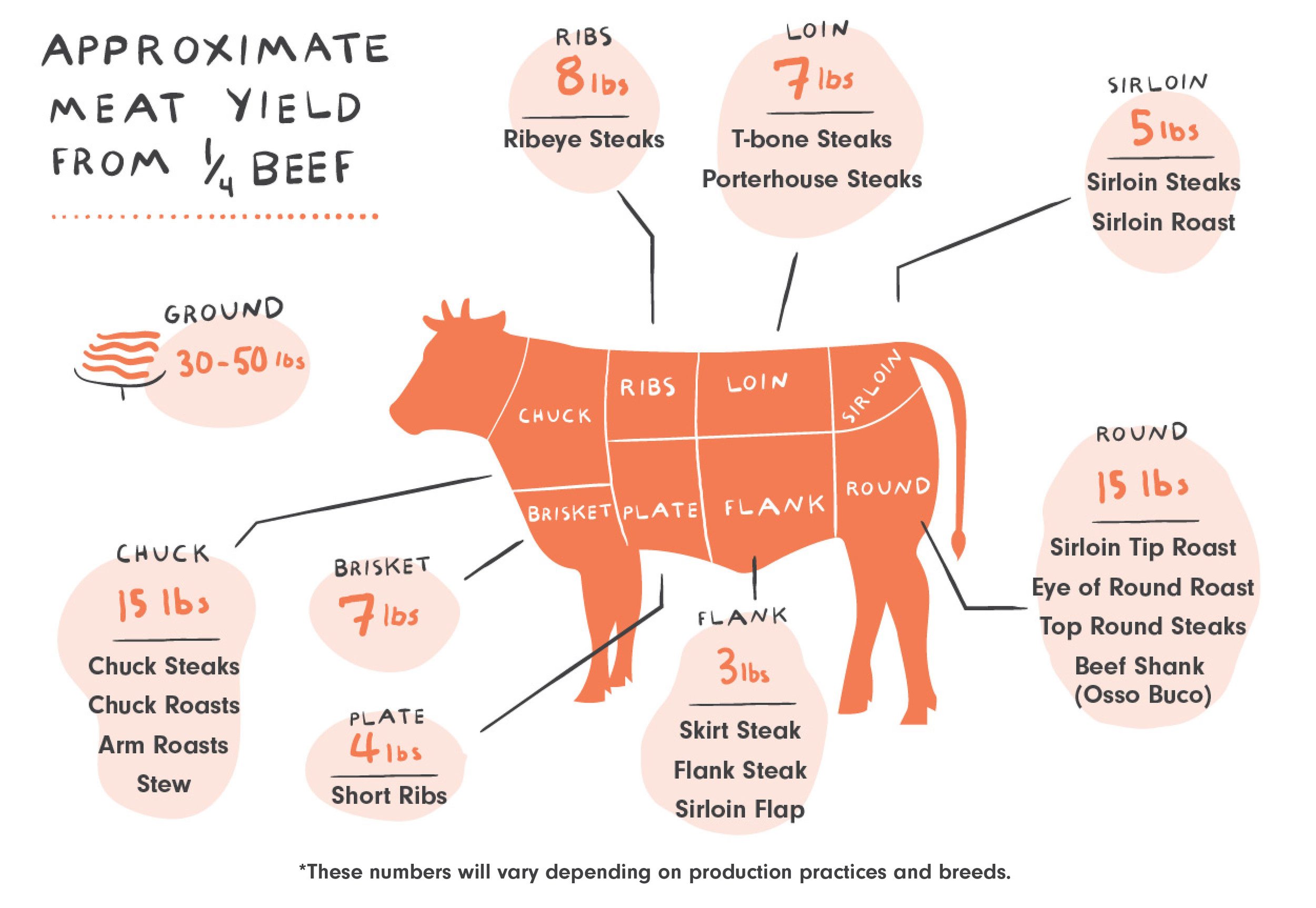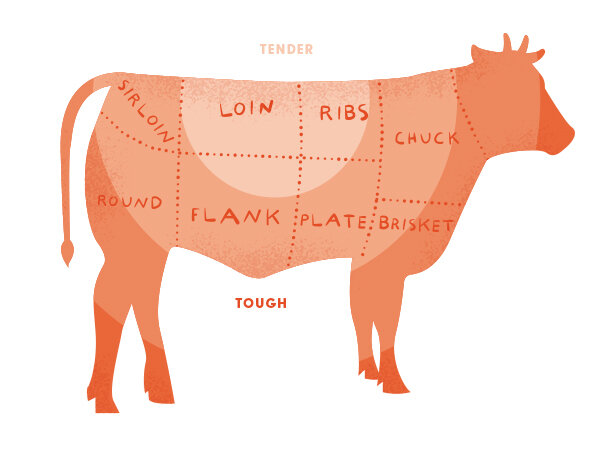How to Break Down Beef Shoulder Clot
Beef: Choosing and cooking cuts


Skip to:
How to Cook Beef Cuts

Beef is the largest species of livestock that routinely ends up in our freezers and on our plates. If you're purchasing from local producers, you'll most likely be buying a "share" of the whole animal, alongside other people with whom you'll be splitting the yield after slaughter and butchering. The most common share sizes are a half, a quarter, or an eighth of beef.
A half-share, also known as a side of beef, is literally half of the carcass, split down the middle of the spine, providing you a choice of every available cut. Typical carcass weights for half-shares range from 200 to 300 pounds.
A quarter-share would be a smaller selection of cuts from each region of a side of beef, the total amount equaling one-quarter of the total carcass weight. Depending on the producer, a quarter-share may allow for customization. If not, all quarter-shares include the same selection of cuts. Quarter-shares are often in the range of 100 to 150 pounds carcass weight.
An eighth-share, sometimes known as a "beef box share," is most often a small variety, representing each main category of cut: roasts, steaks, and grind. Eighth-shares won't typically offer customization and range from 50 to 70 pounds carcass weight.

How to choose beef cuts
The terminology for beef cuts generally falls into the four main categories: steaks, roasts, cubed, and ground.
Steaks
Beef steaks tend to be separated into two camps: thick or thin. Thick steaks, 1 - 1 ¼ inch in thickness, tend to garner the most notoriety and you've probably heard of them already. These include ribeye, t-bone, porterhouse, tenderloin, strip, and sirloin. They come in bone-in and boneless versions. Common thin steaks include skirt, flank, sirloin flap, and flat iron.
Roasts / Cubed / Stew
Beef roasts will range in format based on where they come on the carcass and how large you want them. Cubed formats are going to include kabobs (leaner, quicker cooking cubes meant for dry cooking over higher heat) and stew meat (slower cooking cubes meant for moist cooking over lower heat).
Ground
With any beef share, you are going to have ample amounts of ground beef. The format of ground meat is defined by how fine or coarse it's ground and the amount of lean and fat. The more fat, the more flavor but also the more shrinkage, as the fat melts away during cooking. The default American use for ground beef is burgers and, for that preparation, consider a format of fine grind which ensures tenderness after brief cooking times. For preparations like chili and pasta sauces, a coarse grind provides the right structure to sustain the lengthier cooking times, tenderizing along the way while providing richer flavor. Additionally, for these instances, request lean ground beef, as less fat means the less grease to contend with in your chili or sauce.



In the category of thick steaks, there are some variations to consider. The t-bone and porterhouse steaks are considered a "combination steak." This means that they are two cuts joined by a bone. Those two cuts are the tenderloin and the strip steak. This means you can choose to have t-bone and porterhouse steaks from your beef share, or strip steaks and tenderloins!

One cut to note, in addition to the aforementioned, better known thick steaks, is the Denver steak. It comes from the beef shoulder (chuck) and is cut from a muscle that is flavorful, toothsome, and holds up to both quick and slow cooking. It is worth requesting from your butcher.

How to cook beef cuts
We said this before, but we'll say it again, just about all meat tastes delicious if you cook it right. And you'll know how to cook it right if you have a basic understanding of how an animal moved during its lifetime and how an animal's individual muscles typically move and for what reason. But we know that it's impossible to acquire that kind of knowledge and intuition overnight. For that reason, we've created an easy-to-navigate preparation chart to help guide you. We also recommend heading over to our Resources section where you'll find more recommendations for cookbooks, websites, and more to guide you in the kitchen
Note that we have not included the methods of sous vide or pressure cooking in this chart, because these are methods that can be applied to nearly every cut. We encourage you to try these methods, if you have the equipment to do so.
Cooking chart best viewed on laptop or desktop.
Key
Bar—Barbecue
Bra—Braise
Bro—Broil
Gr—Grill
PF—Pan Fry
PR—Pan Roast
Ro—Roast
| Primal | Common cut name | Also known as | Formats | Prep (see key) |
|---|---|---|---|---|
| Chuck | Chuck-eye Steaks | Delmonico | Bone-in, Boneless | Bro, Gr, PF, PR |
| Ranch Steak | Shoulder Clod Steak | Boneless | Bro, Gr, PF, PR | |
| Flat Iron | Top Blade | Boneless | Bro, Gr, PF, PR | |
| Shoulder Tender | Petit Tender, Teres Major | Boneless | Gr, PR | |
| Chuck Eye Roll | Boneless | Bar, Ro | ||
| Shoulder Clod | Shoulder Center, Clod Heart, Ranch Steak | Boneless | Bar, Ro | |
| Chuck Roast | 7-Bone Roast | Bone-in, Boneless | Bar, Bra, Ro | |
| Arm Chuck Roast | Round Bone Roast | Bone-in, Boneless | Bar, Bra, Ro | |
| Denver Roast | Under Blade Roast, Chuck Short Ribs | Boneless | Bar, Bra, Gr, Ro | |
| Denver Steak | Under Blade Steak | Boneless | Bro, Gr, PF, PR | |
| Brisket | Point, Flat | Boneless | Bar, Bra | |
| Neck | Bone-in, Boneless | Bra | ||
| Rib | Ribeye | Delmonico | Bone-in, Boneless | Bro, Gr, PF, PR |
| Rib Roast | Standing Rib Roast | Bone-in, Boneless | Bar, Ro | |
| Back Ribs | Bone-in | Bar, Bra, Gr, Ro | ||
| Plate | Short Ribs | Flanken Ribs, English-style Ribs | Bone-in | Bar, Bra, Gr |
| Navel | Boneless | Bar, Bra | ||
| Loin | T-Bone/Porterhouse Steak | Bone-in, Boneless | Bro, Gr, PF, PR | |
| Strip Steak | New York Steak, Kansas City Steak | Bone-in, Boneless | Bro, Gr, PF, PR, Ro | |
| Tenderloin | Filet Mignon | Boneless | Bro, Gr, PF, PR, Ro | |
| Strip Roast | Loin Roast | Bone-in, Boneless | Bar, Ro | |
| Top Sirloin Steak | Baseball Steak | Boneless | Bro, Gr, PF, PR | |
| Sirloin Cap | Culotte | Boneless | Bro, Gr, PF, PR | |
| Bone-in Sirloin Steak | Pin-bone Steak | Bone-in | Bar, Bro, Gr, PR, Ro | |
| Tri-Tip | Santa Maria Steak | Boneless | Bar, Gr, PR, Ro | |
| Flank | Flank Steak | London Broil | Boneless | Bro, Gr, PR |
| Skrit Steak | Outside Skirt, Inside Skirt, Fajita Meat | Boneless | Bro, Gr, PF, PR | |
| Sirloin Flap | Flap Meat, Bavette | Boneless | Bro, Gr, PF, PR | |
| Hanger Steak | Butchers Steak | Boneless | Bro, Gr, PF, PR | |
| Round | Sirloin Tip Steak | Kuckle Steak, Rump Steak | Boneless | Bro, Gr, PF, Ro |
| Sirloin Tip Roast | Knuckle Roast, Rump Roast | Boneless | Bar, Ro | |
| Top Round Steak | Bistro Steak | Boneless | Bro, Gr, PF, PR | |
| Top Round Roast | London Broil | Boneless | Ro | |
| Eye of Round Steak | Minute Steak | Boneless | Bro, Gr, PF, PR | |
| Eye of Round Roast | Boneless | Ro | ||
| Bottom Round Roast | Outside Round Roast | Boneless | Bar, Bra, Ro | |
| Offal & Bones | Heart | Boneless | Bra, Bro, Gr, PF | |
| Tongue | Boneless | Bra | ||
| Liver | Boneless | Gr, PF, PR | ||
| Kidneys | Boneless | Bro, Gr, PF, PR | ||
| Oxtail | Boneless | Bra | ||
| Cheeks | Boneless | Bra | ||
| Shanks | Boneless | Bra | ||
| Marrow Bones | Bone-in | Gr, Ro |

A concise glossary of cooking methods
Quick-cooking methods
Broil
A quick-cooking method involving a high-heat source elevated above the meat. Basically, an inverted grill with less control over temperature.
Recommended for cuts 1½-inches or thinner that lay flat.
Grill
A dry-heat quick-cooking method that involves a high-heat source below the meat. Fuel is provided through charcoal or gas. Smoke can be added, often with wood chips or sawdust.
Recommended for quicker cooking cuts, less than 2-inches thick.
Pan-Fry
A quick-cooking, stovetop method where meat is seared in a hot pan and flipped at least once.
Recommended for tender cuts less than 1-inch thick.
Pan-Roast
A combination cooking method where meat is seared in a hot pan on the stovetop, flipped, and then transferred into a low-degree oven to finish cooking. (You can also flip this order, starting in a low-degree oven and finishing in a hot stovetop pan, a technique known as a reverse sear.)
Recommended for tender cuts 1- to 2-inches.
Slow-cooking methods
Barbecue
A slow-cooking preparation where meat is cooked at low temperatures for extended periods. Wood or charcoal acts as the heat source while also providing smoke. Barbecue can involve dry- and moist-heat, depending on how humidity is controlled.
Recommended for ribs or large cuts that have adequate amounts of connective tissue and/or fat, most often from the forequarter of the carcass.
Braise
A moist-heat, slow-cooking preparation where meat is cooked submerged in or surrounded by a liquid; can be performed on a stovetop, in an oven, or with a slow cooker.
Recommended for tougher cuts with abundant amounts of connective tissue.
Roast
A dry-heat slow-cooking method where the meat sits in an uncovered vessel, most often in an oven.
Recommended for cuts thicker than 2" or large, lean cuts.
Source: https://www.goodmeatbreakdown.org/beef